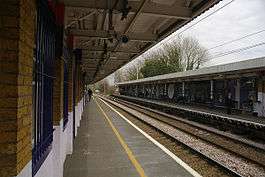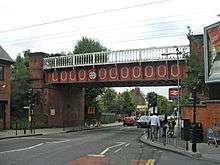Enfield Chase railway station
Enfield Chase railway station is located in Windmill Hill, Enfield, in the London Borough of Enfield, north London, 9 miles 9 chains (14.67 km) from London King's Cross[2] on the Hertford Loop Line. It is in Travelcard Zone 5.
| Enfield Chase | |
|---|---|
 | |
 Enfield Chase Location of Enfield Chase in Greater London | |
| Location | Enfield Town |
| Local authority | London Borough of Enfield |
| Managed by | Great Northern |
| Station code | ENC |
| DfT category | D |
| Number of platforms | 2 |
| Fare zone | 5 |
| National Rail annual entry and exit | |
| 2014–15 | |
| – interchange | |
| 2015–16 | |
| – interchange | |
| 2016–17 | |
| – interchange | |
| 2017–18 | |
| – interchange | |
| 2018–19 | |
| – interchange | |
| Key dates | |
| 4 April 1910 | Opened |
| Other information | |
| External links | |
| WGS84 | 51.6529°N 0.0908°W |
The station, and all trains serving it, is operated by Great Northern. It is directly west of Enfield Town centre. The current station opened in 1910 with the extension of the Hertford Loop Line to Cuffley, replacing a previous station a short distance to the west which opened in 1871. Originally called simply "Enfield" station, the current name was adopted in 1924 to avoid confusion with Enfield Town.
Services
The service runs to Moorgate via Highbury & Islington. The service uses Class 717 EMUs.
The typical off-peak weekday service is 4 trains per hour to Moorgate and to Hertford North; two of the latter per hour continue to Watton-at-Stone one of which continues further to Stevenage.[3]
In peak hours, the line runs a more frequent service between Moorgate and Gordon Hill, calling at Enfield Chase.
On Saturdays, there is a half-hourly service to Watton-at-Stone and an hourly service to Stevenage, and two trains per hour to Moorgate.
| Preceding station | Following station | |||
|---|---|---|---|---|
| Grange Park | Great Northern Hertford Loop Line |
Gordon Hill | ||
History
The original terminus
The original Enfield Station in Windmill Hill opened on 1 April 1871 as the terminus for the Great Northern Railway branch line from Alexandra Palace. By 1887, 37 trains a day left Enfield, mainly for King's Cross, but also to Broad Street and until 1907, to Woolwich and Victoria.[4] The station building was a two-storey twin-gabled house, similar in style to the single-storey building at Palmers Green. It was sited lengthways across the end of the track. The single island platform was covered by a wide canopy for much of its length. Enfield Station had been intended to bring prosperous middle-class commuters to the area. A journalist visiting the station in 1885, saw a sign advertising cheap workmen's tickets for trains scheduled to arrive in London before 8 am, only to find that the timetable showed that there were no trains that met that criterion.[5] The old Enfield Station closed to passengers in 1910 and was replaced by the present station, but remained in use as a goods depot until 1974. The surviving buildings were demolished and replaced in the 2000s with housing along a new street, Gladbeck Way.[6]
The new high level station
By the end of the 19th century, there was a need to relieve the pressure on the main line to the north out of Kings Cross, and a plan to continue the Enfield branch to Hertford and Stevenage was conceived. An Act of Parliament was passed in 1898, and the GNR set about acquiring and demolishing houses and compensating land owners in the area. Work on the line commenced in 1906.[7] The new Enfield Station was sited a few hundred yards to the east of the existing one, and raised above ground level so that north bound trains could access a new bridge crossing the road at Windmill Hill. It opened on 4 April 1910 for services as far as Cuffley. The first through train to Stevenage did not run until 4 March 1918, because of a host of legal and engineering difficulties, and shortages of men and material caused by World War I. The name Enfield Chase was adopted in 1924, to avoid confusion with Enfield Town station.[8]

Connections
London Buses routes 121, 231, 307, 313 and 377 serve the station.
References
- "Station usage estimates". Rail statistics. Office of Rail Regulation. Please note: Some methodology may vary year on year.
- Padgett, David (October 2016) [1988]. Brailsford, Martyn (ed.). Railway Track Diagrams 2: Eastern (4th ed.). Frome: Trackmaps. map 24A. ISBN 978-0-9549866-8-1.CS1 maint: ref=harv (link)
- Table 24 National Rail timetable, May 2016
- Baker, T F T; Pugh, R B, eds. (1976). "A History of the County of Middlesex". Victoria County History. p. 212. Archived from the original on 26 May 2011.
- Pam, David (1992). 1837 to 1914, A Victorian Suburb. A History of Enfield. Two. Enfield Preservation Society. ISBN 0-907318-10X.
- "Enfield". Disused Stations. Archived from the original on 6 February 2014.
- "Great Northern Railway proposed extension route for Parish of Enfield". Exploring 20th Century London. Archived from the original on 16 June 2012.
- White, H P (1971). Greater London. A Regional History of the Railways of Great Britain. III. David & Charles. pp. 169–170. ISBN 0-946537-39-9.
External links
| Wikimedia Commons has media related to Enfield Chase railway station. |
- Train times and station information for Enfield Chase railway station from National Rail
- "History of Enfield from local government". Enfield Borough Council. Archived from the original on 10 March 2007.